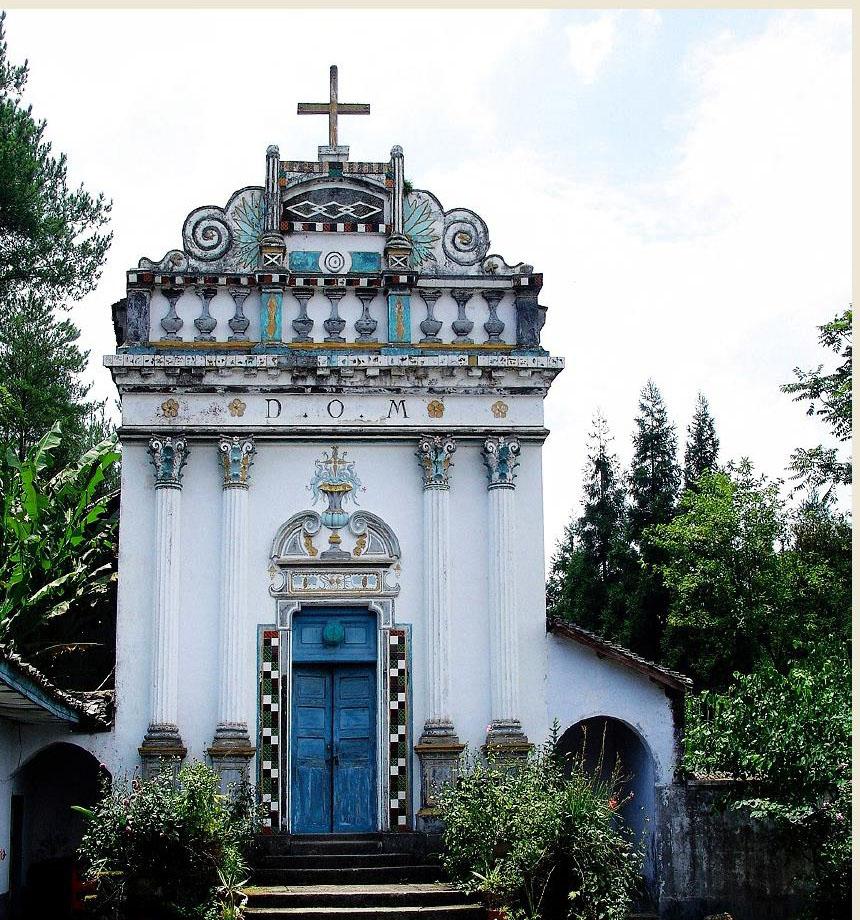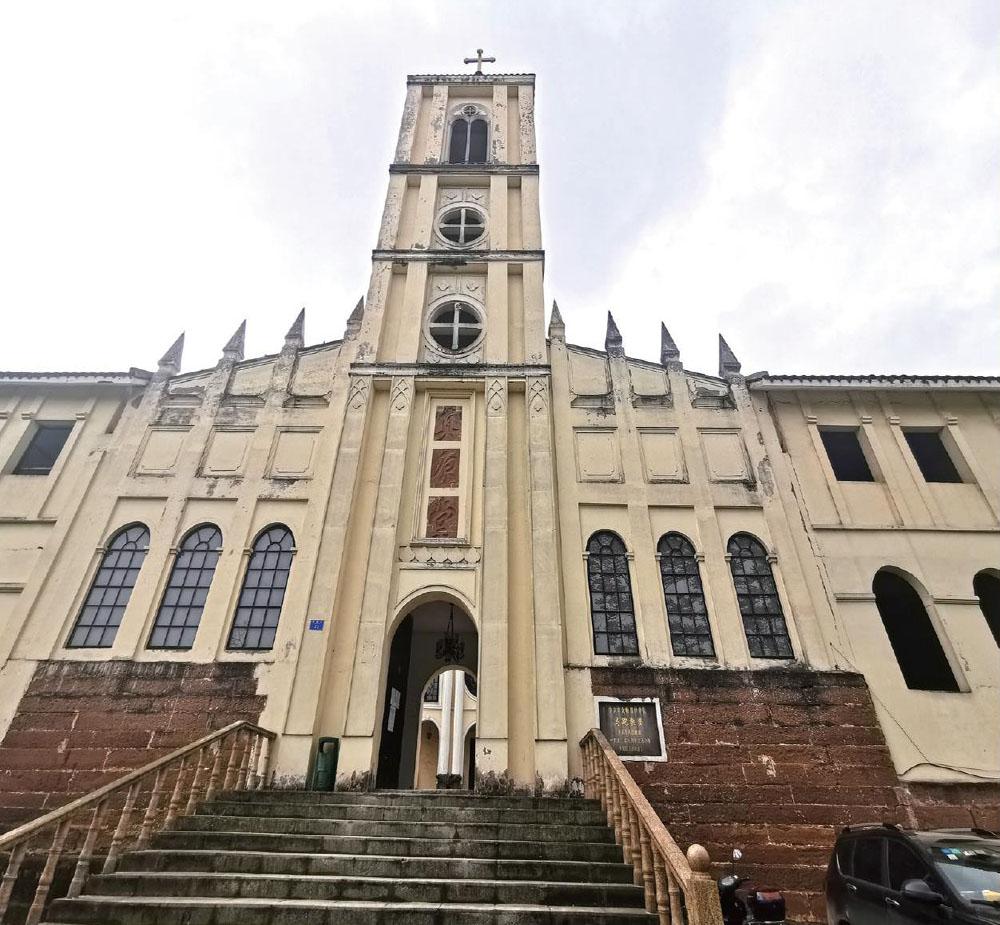曾经的教堂 今为文物保护单位
2021-09-08杨艳
杨艳



1891年,重慶正式开埠。门户洞开之后,英、法、日等国纷纷在重庆设海关、建码头、修仓库、开洋行。此外,英、美、法的传教士沿着长江深入中国腹地,纷纷来到西部门户重庆传教,修建教堂,办学堂、医院,留下了大量文化遗存。
坐落在南岸区鸡冠石镇群山之中的法国大教堂,又称“慈母山修院”,主讲经堂简称为“慈母堂”。这里林深叶茂,可远眺长江。教堂以其历史渊源、优越的地理位置、特有的建筑风格,如今吸引了大量游客。
鸡冠石法国大教堂始建于清朝,法国天主教川东教区副主任纳慈宣经过多处勘察后,选定南岸鸡冠石观音山麓为修院地址,1911年动工,1913年建成,至今已有上百年历史。1939年夏,蒋介石偕夫人宋美龄曾来此参观,赞曰:真福地也。
慈母山修院呈三合院布局,院内树木葱茏,环境幽静,其中由多道拱门构成的廊道极具美感。座南朝北,占地面积80余亩,总建筑面积3420平方米,院内有大、小房间80余间,院内房屋为西式建筑,主体建筑礼拜堂高约18米,大厅为罗马式教堂建筑风格,穹窿顶,五颜六色的玻璃窗,圆柱上雕刻花草纹浮雕。整个礼拜堂显得宽敞明亮,庄严肃穆。院内现尚存6棵伊拉克枣树,高约6米,为重庆市珍稀树种。
这里作为天主教重庆教区神学院所在地,先后创办天主教大、中、小修院,培养学生350余人。
马跑教堂位于距大足县城15公里的石马镇,是渝西地区最大的天主教堂。由法籍罗兰神父主持修建,于1904年修建竣工,至今已有100多年历史,被列为重庆市第一批重点文物保护单位。19世纪末,这里曾发生了著名的“大足教案”事件,为当时重大教案之一。
马跑教堂系法国哥特式教堂建筑,其垂直型框架结构给人以伟岸挺拔、高耸入云之感。教堂内有水池、平房、木楼、地下室、来宾楼。庭院幽静,古树参天,是以传统北方四合院为主要建筑格局,中西合璧的建筑群落。教堂经历过数次修缮,至今保持完好,其中尤以钟楼、正经堂、圣母亭最为著名。
忠县城西20公里有一座天池森林公园,海拔1092米,山高林密,物产丰饶。在这山巅之上,有一座欧式建筑—天池天主教堂。
据《忠县志》记载,清光绪十七年(1891年),法籍天主教徒于池前修建“震野修院”又名“天池修院”,可容男女修士百余人,并设教会小学堂于此。
整座教堂分三部分:上天池占地2500多平方米,建有哥特式尖顶大教堂;中天池是神职学校震野中修院,占地1万多平方米,有足球场、网球场、篮球场、游泳池;下天池是欧式山庄的教职员宿舍,占地3000平方米。但这些建筑有所损坏,教堂在1986年完成修复。
巫山县西南边陲,距县城57公里的庙宇镇,有一座建筑精美,堪称渝东地区最大、保存最完整的天主教堂,名叫圣安多尼堂。因建筑精美,圣安多尼堂被评为“重庆市优秀近现代建筑”。
《巫山县志》记载,光绪二十二年(1896年),法国神父德司望来县,在庙宇镇耗时7年创建天主教堂,占地5458平方米,其中房屋建筑面积2482平方米。圣安多尼教堂兴盛时期,礼拜的教徒曾达到2000余人。该地率先办起天主女学校,招收学生100余人,从法国购来铜鼓、铜号供教学之用,钟楼的钟声可以传到几十里外。1945年,教堂运来西药,创办天主堂诊疗所,附带办学。
如今的庙宇镇上还随处可见德司望带来的无花果,成了庙宇镇一大经济作物。
图片/相关区县宣传部 文化旅游委 文管所提供
In 1891, Chongqing was officially opened as a port. After port opening, Britain, France, Japan and other countries had set up customs, built docks, constructed warehouses and opened foreign firms in Chongqing one after another. In addition, British, American and French missionaries went deep into the hinterland of China along the Yangtze River and finally arrived in Chongqing, the gateway to the west. They did missionary work, built churches, ran schools and hospitals, leaving behind numerous cultural relics.
Located in the mountains of Jiguangshi Town, Nan'an District, the French Cathedral is also known as "Cimu Mountain Monastery" with the main lecture hall called "Cimu Hall" in short. Surrounded by deep forest and lush leaves, one can look into Yangtze River here from a distance. The church's historical origin, superior geographical location and distinctive architectural style have attracted numerous tourists at present.
First built in the Qing Dynasty, after several reconnaissance trips by Natsu, deputy director of the French Catholicism Eastern Sichuan Parish, Guanyin Mountain, Jiguanshi, Nan'an District was selected as monastery site of Jiguangshi French Cathedral. The construction was started in 1911 and completed in 1913, spanning over a century. In the summer of 1939, Chiang Kai-shek and his wife, Soong Mei-ling, visited this place and lauded it as "a truly blessed place".
A three-section compound, Cimu Mountain Monastery boasts lush trees and tranquil environment in the yard as well as a highly aesthetic gallery composed of multiple arches. Facing north with an area of 80 mu and a total floor area of 3,420 square meters, the monastery has 80-plus various rooms of Western style with a 18-meter high main building chapel, a Roman-Church-architecture-styled lobby, a dome roof, colorful stained glass windows, and plant embossment carved on round columns. The whole chapel gives a spacious, bright and solemn presence. Six 21.87 feet-high Iraqi jujube trees still stand in the monastery and have been listed as the rare tree species in Chongqing.
As the site of the Catholic seminary of Chongqing parish, it has successively established Catholic major, medium and minor monasteries with over 350 students trained.
Located in Shima Town, 15 kilometers away from Dazu County, Mapao Catholic Church is the largest Catholic Church in Western Chongqing. Initially constructed by French priest Roland and and completed in 1904, the church has century-old history and is listed as the first batch of key cultural relics protection units in Chongqing. At the end of the 19th century, the famous "Dazu Church Uprising" took place here. It was one of the major church uprising at that time.
Mapao Catholic Church has a French Gothic styled with vertical frame structure, giving a towering presence. There are ponds, single-storey buildings, wooden buildings, basements and guest buildings in the church. With majestic ancient trees in tranquil yard and a traditional northern quadrangle dwelling as the main architectural pattern, the church is a building cluster with a combination of Chinese and western styles. Though the church has undergone several repairs, it remains intact, especially with the bell tower, the Orthodox Hall and the Virgin Mary Pavilion as the most reputed buildings.
Located 20 kilometers west of Zhong County, with an altitude of 1,092 meters, Tianchi Forest Park boasts high mountains, lush forests and abundant products. On the pinnacle of the mountain perches a European-styled building - Tianchi Catholic Church.
According to the Zhong County Annals, in the 17th year (1891) of the reign of the Guangxu Emperor in the Qing Dynasty, French Catholics built a "Zhenye Monastery" in front of the pond, also known as "Tianchi Monastery". It could accommodate over 100 nuns and monks, and had set up a church primary school here.
The whole church is divided into three parts: the upper Tianchi covers an area of over 2,500 square meters with a Gothic spire cathedral; the middle Tianchi is a seminary - Zhenye medium monastery, covering an area of 10,000-plus square meters, with a football field, tennis court, basketball court and swimming pool; the lower Tianchi is the faculty dormitory of European villa, covering an area of 3,000 square meters. However, some of these buildings were damaged, and the church was repaired in 1986.
On the southwest border of Wushan County, in Miaoyu Town, 57 kilometers away from the county, an exquisite building, namely St. Anthony's Church, is basically the largest and best preserved Catholic Church in eastern Chongqing. Thanks to its sophisticated architecture, St. Anthony's Church was rated as "Exceptional Modern Building in Chongqing".
According to Wushan County Annals, in the 22nd year (1896) of the reign of the Guangxu Emperor in the Qing Dynasty, the French priest Scarella spent seven years in Miaoyu Town to establish a Catholic Church. It covers an area of 5,458 square meters, including 2,482 square meters of housing construction area. During the prime time of St. Anthony's Church, the number of believers once reached over 2,000. The church took the lead in setting up a Catholic girls' school, enrolling over 100 students, and bought copper drums and brass trumpets from France for teaching. The bell tone of the bell tower could be heard dozens of miles away. In 1945, the church brought Western medicine and founded a Catholic clinic as well as a school.
Today, figs brought by Scarella can be seen everywhere in the Miaoyu Town as a major cash crop here.
Photos/Provided by publicity departments, cultural tourism committees and cultural relics management offices of relevant districts and counties
